Products
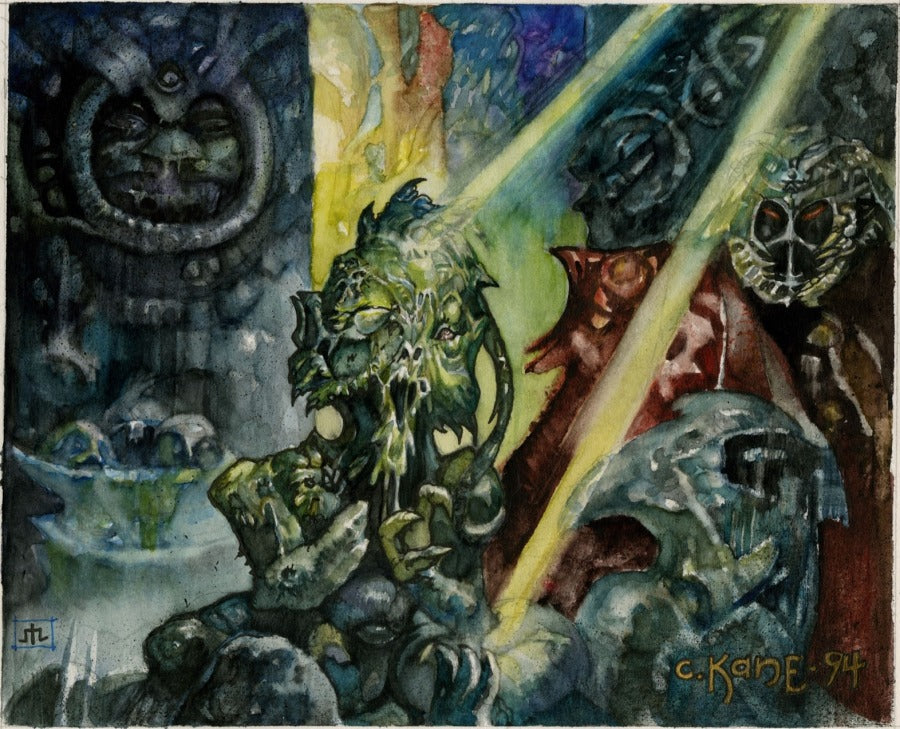
Crawling From the Pits: The Morphology of Thrulls
November 01, 2023 8 min read 0 Comments
“Above all, a well crafted Thrull should be hideous—blasted of countenance and twisted of limb—to inspire fear and revulsion.” —Endrek Sahr, Master Breeder
The first Thrulls crept their way into Magic: The Gathering via 1994’s often derided Fallen Empires expansion. Thrulls are a creature type unique to the world of Magic. The name Thrull is very similar to the word “thrall”, meaning captive or slave, and I imagine that’s where the name came from.
We covered the evolution of Slivers last time, and it's time for Thrulls today.
Fallen Empires (1994)
Canonically, Thrulls were created through necromancy by Endrek Sahr of The Order of The Ebon Hand, a cult established by the necromancer Tourach and his followers on the Dominarian continent of Sarpadia. It’s important to note a distinction between Thrulls and Skaabs or other Zombies. While all are derived through necromancy of some fashion, Thrulls are living beings grown from the flesh of the dead, not the reanimated flesh of the dead themselves. It’s a minor distinction, until we look closer at the function Thrulls served in The Order.

Initially, Thrulls were bred for sacrifice as part of The Order’s necromantic rituals. One such ritual, the Soul Exchange, sacrificed the life of one living being to restore the life of another. The use of Thrulls in the ritual, as reflected in the gameplay effect of the card and depicted in the Anthony S. Waters illustration, enhanced the power of the spell. Much of The Order’s necromancy drew its power from the sacrifice of the living.

The place where The Order practiced the necromancy it used to breed its Thrulls was called the Breeding Pit. The Pit has had two artistic depictions. The original Anson Maddocks piece does a great job of showing visually the necromantic process. We can see the flesh and magic weaving together into a half formed being. The half-formed creature in the Maddocks piece, however, looks a bit too attractive for the definition of Thrulls as “hideous—blasted of countenance and twisted of limb.” The Fifth Edition piece has a different focus, less on the result of the ritual, and more on the ritual itself. This is perhaps the more fitting piece of the two, given the context, though the Maddocks piece has a certain gothic appeal.
After establishing Thrulls as part of their necromantic rituals, The Order of the Ebon Hand soon bred Thrulls for other purposes as well. As we will see, The Order’s use of Thrulls for various kinds of sacrifice—not just ritually, but also as expendable cannon fodder in battle—is conveyed through gameplay mechanics of many Thrull cards as well as cards which reference Thrulls.




The Basal Thrull is the earliest and one of the most basic types of Thrull in the lore. In the game, Basal Thrull is a common card, and like many common cards in Fallen Empires, there are four pieces of art depicting it. The Christopher Rush depiction almost looks too badass to depict a creature of such low power gameplaywise. It almost feels like a wasted use of such a fierce looking monster. The Kaja and Phil Foglio pieces both have a bit of cutesiness to them, as is their styles. Phil’s piece showing the weak Thrulls strung up awaiting sacrifice feels more appropriate of the two.
Leave it to Richard Kane Ferguson to have what for me feels like the most definitive depiction of Thrulls generally. Dark shadows loom while rays of magical light appear to bring the Thrull to life in the foreground as a mysterious figure looks on in the background. This image makes you feel like you’re right there in the Ebon Stronghold watching the ritual take place.
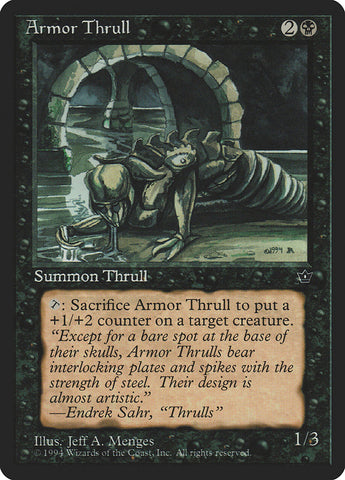
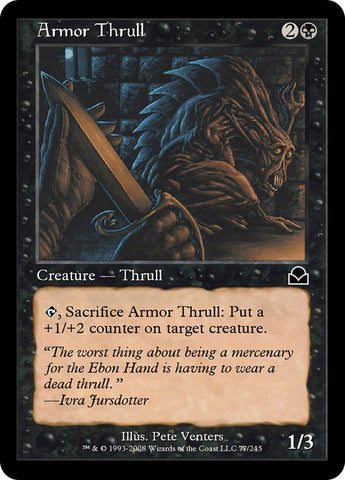
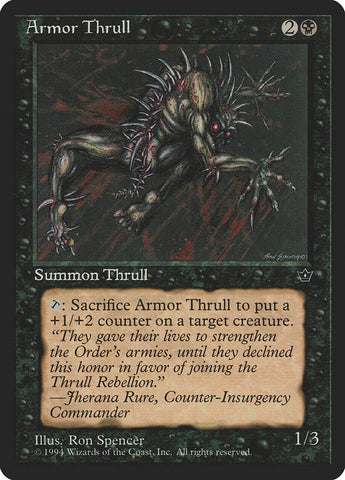

The second of the two common Thrulls in the set, Armor Thrull also has four art depictions. The Armor Thrull is the creature The Order sacrificed to make armor for the warrior clerics in its service. The Scott Kirschner image of a man wearing the armor feels out of place on a card meant to depict the creature while still living. The flavor text on this version must have been written after to save or explain away the lack of a living Thrull in the artwork, but this feels like a miss compared to the others.
Ron Spencer’s Armor Thrull is a spiny monster with glowing red eyes depicted as though clinging to the wall above. Like Christopher Rush’s Basal Thrull earlier, this depiction feels too fierce, almost predatory, for the creature it’s meant to depict. This is another missed opportunity where the art could have appeared on a more appropriate card. Jeff A. Menges’s piece is more on track showing the Thrull as a docile creature, but it’s Pete Venters’ Thrull that really captures the card. The Thrull huddles in fear in the background as someone off image sharpens a knife in the foreground in preparations for sacrificing it. It’s an ominous image that establishes the power of Thrulls in The Order’s hierarchy. While most Thrulls are sacrificial objects, not all are as docile as these first Thrulls we’ve seen.
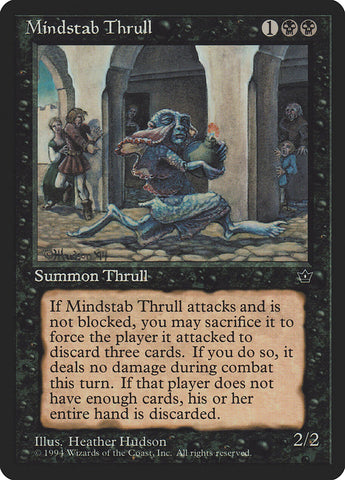


Moving up through the hierarchy of Thrulls we arrive at Mindstab Thrull. These Thrulls appear to have more agency than the Armor and Basal Thrulls. It’s unclear what their function is in The Order. Are they weapons, or living torture devices for use against captured enemies?
While still a common, there are only three depictions of Mindstab Thrull instead of four. The Heather Hudson art depicts a supposed Thrull running through a crowded market carrying a bomb. The image feels more like it’s depicting a Goblin from Goblin Grenade, another card in Fallen Empires with three art variants. Ron Spencer’s Armor Thrull, with its menacing spines, would have made a much better depiction here. While I appreciate Richard Kane Ferguson’s knife-wielding Thrull, Mark Tedin’s scalpel-wielding multi-armed monstrosity captures the essence of a creature brought to life from the animated parts of the dead to serve The Order.
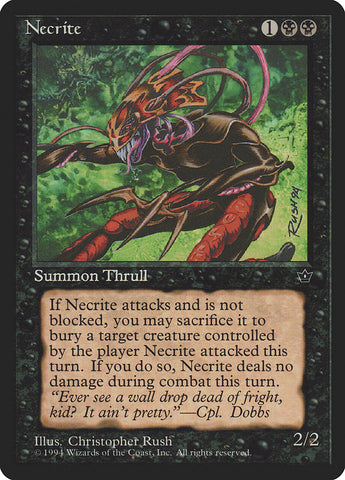
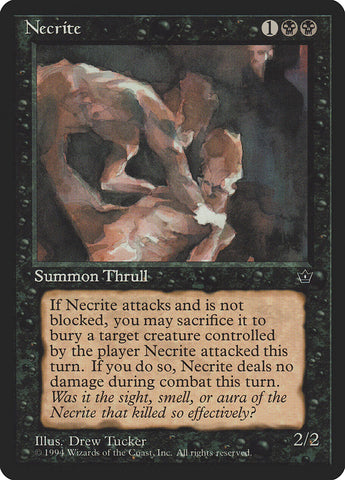

Necrites are the fiercest looking of all the Thrulls we’ve discussed so far. It’s clear from the Christopher Rush and Ron Spencer depictions that they were bred as weapons to use against enemies of The Order. The insect-like creature in the Christopher Rush image calls to mind the alien Chryssalids from the ‘90s X-COM: UFO Defense PC game. The scariest of the three by far is the Ron Spencer illustration. The bulbous eyes, the bugs crawling over it, and the way it looks like it’s cutting its own tongue and licking the blood is deliciously creepy. I’d go so far as to call it the creepiest illustration in all of Magic.
The vague undefined creatures in the Drew Tucker piece are a bit of a letdown compared to the other two images. The piece sets an interesting mood but might have been better suited to depicting one of the lesser Thrulls.

Thrull Wizards, as the flavor text tells us, are the first intelligent Thrulls. This card is significant in a few ways. It’s the first Thrull we’ve looked at which does not have a sacrifice ability in gameplay. According to the lore, it was intelligent Thrulls like the Thrull Wizards who rebelled against the treatment of their kind. The gameplay effect of the card, countering black spells, is a translation of that part of the lore into the effect of the card. The Thrull rebellion against The Order is a crucial part of the lore of Fallen Empires and appears prominently on the next card we’ll look at.

Like the Thrull Wizards, The Thrull Champion is another Thrull at the forefront of the Thrull rebellion. Bred for combat like the Necrites, this multi-limbed, multi-headed Thrull also wields weapons, as depicted by the large axe it carries. Its combat and leadership ability are reflected in its gameplay ability of pumping the power and toughness of other Thrulls controlled by the player. In addition, the Champion’s ability to gain control of other Thrulls is a gameplay embodiment of the story of the Thrull rebellion. Everything about this card is a flavor win. It’s a fusion of lore and mechanics in a single package. The Daniel Gelon art is fitting, tying the whole card together.
Tempest (1997)
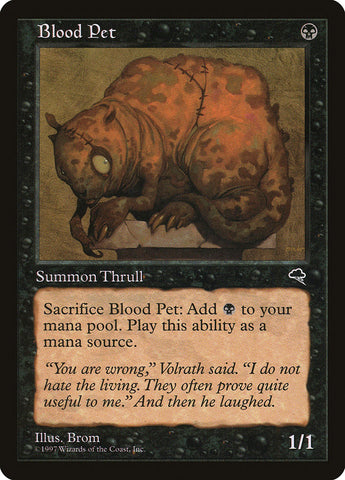
After Fallen Empires, three years passed before Thrulls returned, in a small way, in Tempest Block. One Thrull appeared in each set in the block. The Blood Pet was very similar in function to the previously discussed Basal Thrull, both in terms of gameplay, and if we interpret the flavor text appropriately, in lore. The Brom art is both cute and slightly hideous, a perfect depiction for the card.
Urza’s Saga (1998)
After the three Thrulls of Tempest Block, Blood Vassal was the last Thrull that appeared in Magic for nearly a decade. The Blood Vassal was a tool of the Phyrexians. The art shows an imprisoned creature with all sorts of tubes and wires inserted through its flesh. A hose attached to the creature’s face appears to convey that the victim is being drained of their life essence. While not one of the most iconic images in Magic, the piece succeeds in capturing the body horror that is Phyrexia and all it represents.
Guildpact (2006)
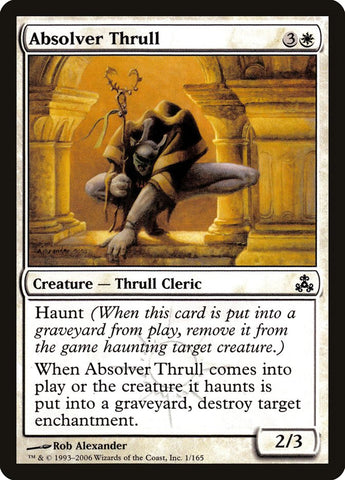
Thrulls were reintroduced into Magic In 2006’s Guildpact set, this time as the servants of the Orzhov Syndicate. The Absolver Thrull is the first non-black Thrull. This semi-intelligent Thrull is a cleric with some sort of role in the Orzhov Syndicate’s church hierarchy. The Absolver is much more humanoid than many past Thrulls, though the Rob Alexander art keeps many features of the creature vague.

The first multi-color Thrull, and the first Thrull that flies, the Mourning Thrull also introduces us to an important tidbit of lore. The Orzhovian Thrulls, much like their predecessors, are formed through a necromantic process like that of The Order of the Ebon Hand. The source of flesh used to start the process is the cast off physical and emotional bodies of the spirits in control of the church syndicate. This reveals a bit about the inner workings of the Orzhov in a few brief lines of text.
The Danny Orizio image has little to do with the flavor text apart from showing what sort of Thrulls the church breeds for their service. Looking at the image, I can’t help thinking of them being reminiscent of the Scourge, flying monsters from the StarCraft franchise.
Dissension (2006)
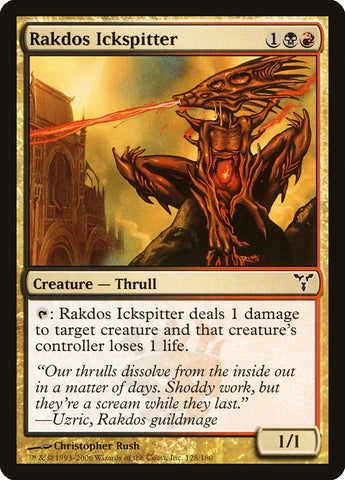
The second multi-color Thrull, Rakdos Ickspitter is the first, and so far, only Thrull to have red in its color identity. Created by the Cult of Rakdos, Ickspitters are not as well-made as their Orzhovian counterparts on Ravnica. While they only last a few days, the Cult sees them as more a form of entertainment than anything else.
Gatecrash (2013)
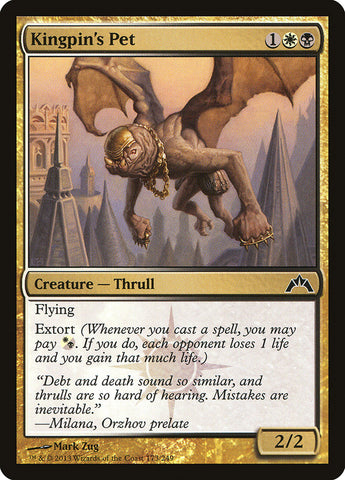
After Guildpact, Thrulls became a fixture of the Ravnican Orzhov guild. They’ve made an appearance each time the storyline has returned to the Ravnica setting. The Kingpin’s Pet is a grotesque enforcer and debt collector for the Orzhov Syndicate. Depicted soaring over the spires of the city of Ravnica, the Kingpin’s Pet inspires fear, carrying a threat of force as much—if not greater—than it delivers.
Dominaria (2018)
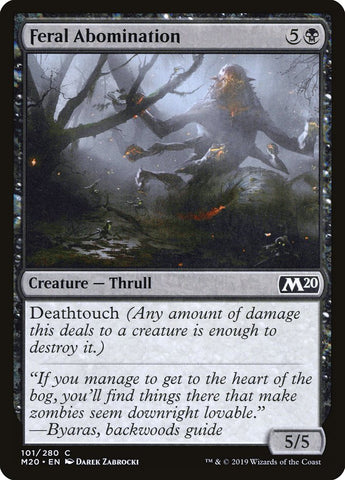
While not the last Thrull to appear in Magic, the Feral Abomination is the first Thrull since Fallen Empires depicted as having spawned on the plane of Dominaria—in this case specifically in Urborg. It’s a massive beast compared to the size of most Thrulls we’ve seen. The fact that it’s wild also opens interesting design and story possibilities. What became of the Sarpadian Thrulls after their rebellion from The Order of the Ebon Hand? Did they survive? Could we see them make an appearance in a future Magic set?
The En-Thrull-ing Conclusion
The history of Thrulls in Magic is almost as long as the history of the game itself. While established as creatures of necromancy, they are more than just creations of black Magic. They can be sentient as well as mindless automatons, and even grow wild in places like Urborg.
What is your favorite Thrull? What creature types would you like to see me explore in the future? Let me know in the comments or on Twitter.
Subscribe
Sign up to get the latest on sales, new releases and more …
